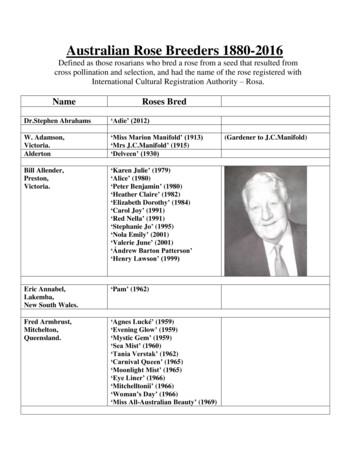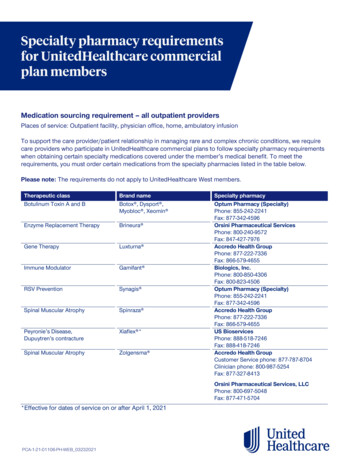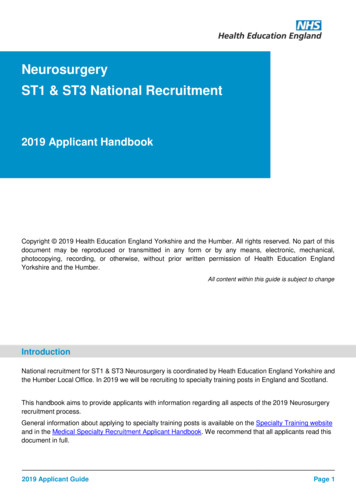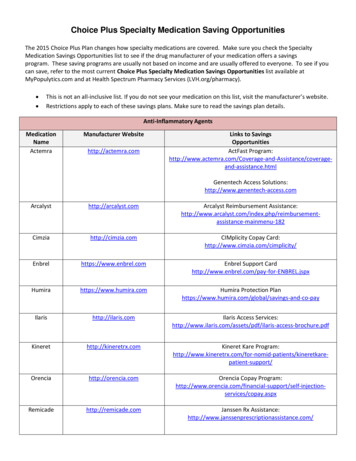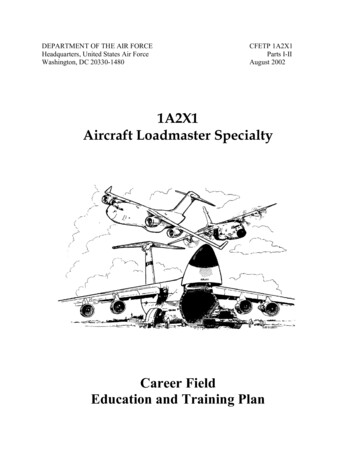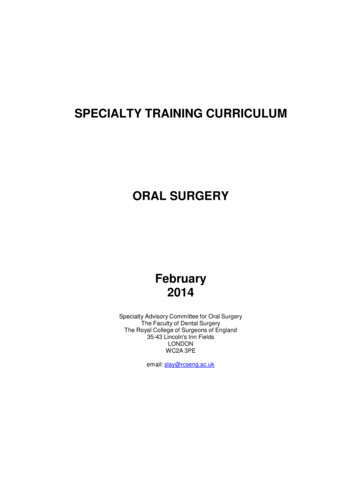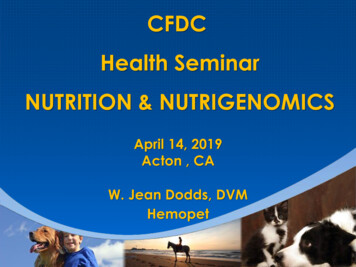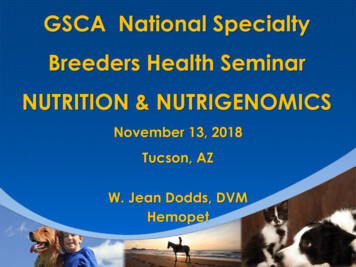
Transcription
GSCA National SpecialtyBreeders Health SeminarNUTRITION & NUTRIGENOMICSNovember 13, 2018Tucson, AZW. Jean Dodds, DVMHemopet
The Picture of Optimal Health
Canine Nutrigenomics: The NewScience of Feeding Your Dog forOptimum HealthW. Jean Dodds, DVMDiana R. Laverdure, MSDog Wise PublishingWenatchee, WA2015
Impact of Diet on Genome & Metabolism GOAL – holistically understand howdietary components interact with/withincells & organisms to develop newstrategies/ products that are nutritious &safe Nutrition is the most important factor forhuman and animal health Health is achieved by understandingmolecular individualized, functionalnutrition4
Functional Nutrition, Foods & Superfoods Functional foods include certain botanicals, amino acids,vitamins and phytochemicals that activate disease-fightinggenes and suppress genes that promote disease Since each individual has an unique genome, a foodbenefitting one might not create the same effect foranother -- and could even prove harmful Commercial prescription diets might work for certainsubsets of animals, but they are too generalized to meetthe individual needs of every animal Commercial foods can send unhealthy messages to thecells as the functional effect of a food is only as good asthe sum total of ingredients
Dietary-Induced Hyperthyroidism In humans, excessive consumption of meat contaminated withthyroid tissue has resulted in exogenous hyperthyroidism Throat /gullet in raw meat fed to dogs & cats causes hyperthyroidism; first recognized in 2012 Dietary hyperthyroidism can be seen in dogs or cats fed red rawmeat diet or fresh or dried gullets (which include thyroid tissue).High circulating T4 concentration in a dog or cat, with or withoutsigns of hyperthyroidism, should prompt a review of the dietaryhistory. Clinical signs are readily reversed upon removing the thyroid contaminated food or treats.
Grain-Free Pet Foods, Taurine and CHD The US FDA stated on July 12, 2018 it is investigating a possible connectionbetween grain-free pet diets, taurine, and dilated cardiomyopathy(DCM), also called canine heart disease (CHD) However, much is still unknown, and various factors impact heart heath :Genetics, diet, scientific research to date, taurine needs for dogs vs cats,interaction between foods when passing through and within the body What do we know about taurine ? Taurine is an amino acid found in animal-based protein and plant sources like soy inamounts that vary with the type of meat or plant Taurine deficiency can lead to CHD in humans, cats and dogs Not an essential, food-sourced amino acid for dogs, but still present in pet foods Cats do need food-sourced taurine to prevent CHD; minimum standards by AAFCO
Even More on Taurine No effect of age, sex, body weight, body size, or diet was seen onplasma and whole blood taurine concentrations Mean whole blood taurine concentrations were lower in dogs fed dietscontaining whole grain rice, rice bran or barley The lowest whole blood concentrations were seen in dogs fed lamb orlamb meal and rice diets Plasma methionine and cysteine concentrations were lower in dogs feddiets with animal meals or turkey, and whole grain rice, rice bran orbarley Delaney SJ, Kass PH, Rogers QR, et al. Plasma and whole blood taurinein normal dogs of varying size fed commercially prepared food. J AnimPhysiol Anim Nutr, 2003: 87(5-6): 236–244. No research has established that grain-free diets can cause heartdisease in dogs
Measuring Taurine in Pets Need diagnostic laboratory experienced with the appropriatereference ranges for circulating taurine (see below). Specialsample preparation, storage and shipping is required using sodiumor lithium heparin anticoagulated tubes. If plasma taurine level isequivocal, whole blood taurine is measured to substantiate thediagnosis of deficiency Amino Acid Laboratory, University of California, Davis, 1020 Vet Med 3B, 1089Veterinary Medicine Drive, Davis, CA 95616; 530-752-5058; Fax /aal.htmlPlasma (nmol/ml)Normal RangeNo Known Riskfor Taurine DeficiencyWhole Blood (nmol/ml)Normal RangeNo Known Riskfor Taurine DeficiencyCat80-120 40300-600 200Dog60-120 40200-350 150
Confounding Factors Confluence (merging) foods Ingredients (quality, meat versus vegetarian; role of beetpulp, taurine, grain-free diets)Knight A, Leitsberger M. Vegetarian versusmeat-based diets for companion animals. Review. Animals 2016; 6: 20 pp. Homemade versus commercial Raw (freeze dried, dehydrated, high-pressure pasteurization) Contamination bacterial, fungal and parasite contamination, metals, thyroid hormone, etc Residual pesticides and herbicides glyphosate (Roundup ); chlorpyrifos, dicambra Aflatoxins and mycotoxins
More Confounding Factors Undeclared ingredients not on the label critically assessed published discrepancies between ingredientsand labeling in commercial pet foods, including those with“novel” or “limited” ingredients and containing micronizedhydrolysates found that the median mislabeling was 45 % of tested diets with arange of 33-83% for the “novel/limited” ingredients ones that areused for food elimination trials, and one hydrolyzed diet Olivry T, Mueller RS. Critically appraised topic on adverse foodreactions of companion animals (5): discrepancies betweeningredients and labeling in commercial pet foods. BMC Vet Res2018: 14:24-28.
Functional Superfoods Functional superfoods include: berries , but notstrawberries; coconut oil; curcumin; medicinalmushrooms; milk thistle; omega-3 fatty acids (EPA andDHA); pomegranates; probiotics; raw honey products (notsuitable for the very young); and spirulina (pre-biotic) Home-prepared diets require separate extra calcium,regardless of the diet’s quality Deficient nutrients that often need supplementing arelinoleic acid; omega-3 fatty acids; selenium; vitamin B-6(pyridoxine); vitamin D; vitamin E; and zinc
NUTRIGENOMICS Emerging science that studies the molecular relationshipsbetween nutrition and the response of genes in the genome inpromoting health Different diets alter gene expression, and production ofproteins/ metabolites Ideal diet contains variety, nutrient-dense, whole foods Specific nutrients affect body responses in a form defined as a“signature” Individual response “Molecular Dietary Signature”
BASIC CONCEPTS OFNUTRIGENOMICS Diet can be serious risk factor for a number of diseases Common dietary ingredients act on animal genomedirectly /indirectly, to alter gene expression/structure Degree of dietary influence on balance of healthy anddisease states depends on individual’s genetic makeup Certain diet-regulated genes play a role in onset, incidence,progression, and/or severity of chronic diseases Dietary intervention based on animal’s nutritionalrequirement/ status plus genotype used to prevent, mitigateor cure chronic disease
5 BASIC CONCEPTS OFNUTRIGENOMICS (CONT’D) Certain diet-regulated genes play a role in onset,incidence, progression, and/or severity of chronicdiseases Dietary intervention based on animal’s nutritionalrequirement/ status plus genotype used to prevent,mitigate or cure chronic disease
Do all foods suit all dogs ?
Future DirectionsNutrigenomics and Canine Health Simple tests for rancidity and antioxidant capacityshould permit dog owners and breeders to selectbetter foods Monitor for antioxidant levels Evaluate rancidity due to oxidation of foods – especiallykibble products – over time. Development of functional foods, e.g. thosecontaining natural Nrf-2 activators, has great promise
Future DirectionsNutrigenomics for Canine Health The effects of other dietary variables, including functionalfoods and saturated vs unsaturated fats need to beevaluated Older, less healthy animals more likely to exhibit higher levelsof disease-related biomarkers. Also more likely to benefitfrom induction of antioxidant pathways Newer biomarkers, including metabolomic analyses,isoprostanes and miRNAs plus provide earlier assessment ofdiet-related health effects in younger animals
DIETARY DIAGNOSTICSFood Sensitivity -- Newer Testing Newer tests can use serum, saliva or feces ELISA or other immunoassay platforms Identify IgG, IgA , or immune complexes to foods in serum (poorlycorrelated to clinical signs) IgA or IgM antibodies to foods in saliva (excellent clinicalcorrelation) Antibodies to foods appear in saliva before GI tract clinical/biopsydiagnosis of IBD or “leaky gut syndrome” Saliva testing can thusreveal the latent or pre-clinical form of food sensitivity[Dodds, WJ JAHVMA, 49, Winter Issue , 32-43, 2017/2018; patented worldwide]
NUTRISCAN SUCCESS CASEDarby, 9 yr, S/F, 68 pounds, Old English Sheepdog Hypothyroid on thyroxine therapy; antihistamine Orange staining on head, ears; black skin eruptions Eating chicken & turkey , plus some fish & corn, veggies Removed these 4 foods , and head, ear & skinimproved
Before EarWRONG FOODBefore CAN SUCCESS CASE (cont’d)Before Skin
NUTRISCAN SUCCESS CASE (cont’d)RIGHT FOODAfter EarAfter HeadNUTRISCANSUCCESSCASEAfter SkinAfter EarRIGHT FOODAfter HeadAfter Skin
BeforeBeforeHypothyroidism & Food Intolerance
AfterThyroid Therapy Nutriscan
BeforeAfter
BeforeAfter
Before -- Face Lesions -- Before
BeforeAfter
Before -- Eye Redness -- After
Nutrigenomics and Canine Health Simple tests for rancidity and antioxidant capacity should permit dog owners and breeders to select better foods Monitor for antioxidant levels Evaluate rancidity due to oxidation of foods –especially kibble product
